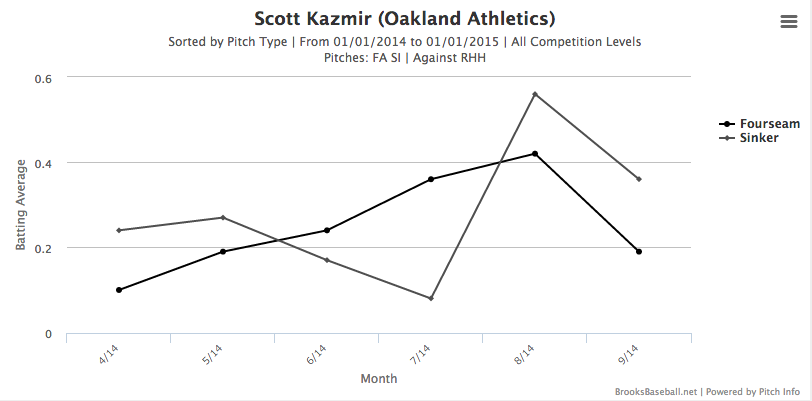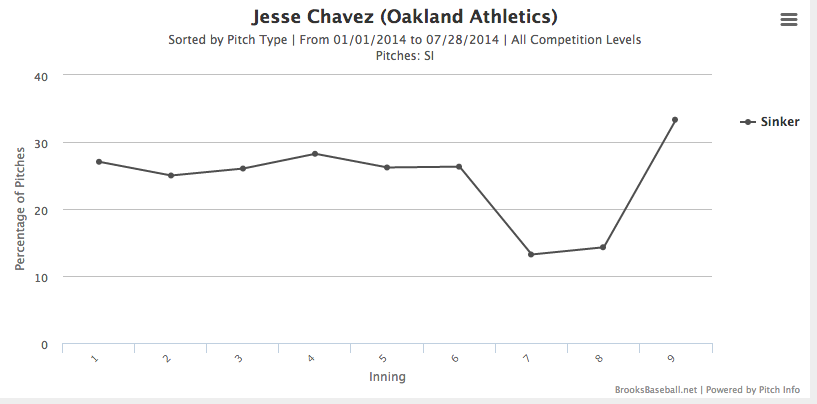If you like what you’re reading then you will like my 2015 Fantasy Baseball Guide! Last year’s fantasy guide was more than 150,000 words and had 440 player profiles (of hitters and pitchers). My approach to player evaluation is to ask questions about what the player has done in the past and what he may do in the future. I certainly provide a narrative on how I feel a player will perform, but I also ask a lot of open ended questions that I hope will get you thinking about the information I’ve provided.
As of early January the A’s have the deepest starting rotation in the majors (assuming Jarrod Parker and A.J. Griffin come back some time in 2015). Below you will find player profiles for each starting pitcher the A’s may call upon to start for them next year. I omitted Parker and Griffin because their injury status is in flux. Since they have so many starting pitchers I only see Sonny Gray making more than 26 starts next year.
Sonny Gray: his write-up can be found here.
Scott Kazmir
Last year it was a tale of two halves for Scott Kazmir. The table below breaks down his first 16 starts compared to his last 16.
| Splits | ERA | WHIP | BABIP | K% | BB% | HR/FB | LOB% |
| 1st 16 | 2.66 | 1.01 | .258 | 21.8 | 6.4% | 9.8% | 79.6% |
| 2md 16 | 4.48 | 1.32 | .317 | 20.5% | 7.4% | 6.7% | 64.2% |
The first half of the year he pitched like an All-Star and in the second half he pitched like the pitcher who was forced to play Independent baseball in 2012. He actually performed really well in July, but once August came he struggled immensely; he posted a 6.05 ERA and 1.50 WHIP. The biggest reason why he struggled was due to inconsistent command of the fastball to righties (image below from BrooksBaseball.net).

Last year Kazmir threw 190.1 innings, which was the second most of his Major League career so it’s possible he did tire towards the end of the season. The A’s acquired a lot of starting pitchers this offseason and if you read between the tea leaves you’ll see the A’s are preparing themselves for life without Kazmir. I can see them trading Kazmir at the trade deadline if they’re out of the race. I can also see them resting Kazmir throughout the year, giving him a couple of starts off to keep him fresh. Therefore, I don’t seem throwing more than 170 innings next year (if stays with the A’s the whole year), which is a positive.
In 2013 he had a 24% strikeout rate, but last year that dropped to 21%, which is fine because he had the highest ground ball rate of his career. The biggest reason for the up tick was the increased usage of the changeup and better location of the slider. In 2013 he was throwing the slider way off the plate (to lefties) to get strikeouts, but in 2014 he was throwing it on the outer edge of the strike zone to get ground balls.
Jesse Chavez
When I look at Jesse Chavez’s body I don’t see a pitcher who can hold up for 200-plus innings, which is also why I’m not surprised he has trouble holding velocity deep into games (image below from BrooksBaseball.net).
 Also, even though he was really good to begin the year he quickly started to fade as he accumulated more innings. The table below breaks down his first 11 starts compared to his last ten last year.
Also, even though he was really good to begin the year he quickly started to fade as he accumulated more innings. The table below breaks down his first 11 starts compared to his last ten last year.
| Splits | ERA | WHIP | BABIP | AVG | K% | BB% | HR/FB |
| 1st 11 | 2.78 | 1.18 | .284 | .238 | 22.7% | 6.4% | 13.3% |
| Next 10 | 4.21 | 1.44 | .333 | .268 | 21.9% | 9.2% | 8.5% |
I’m writing this player capsule in early January and as of right now I have no idea who is going to be the five guys in the starting rotation. The only locks are Sonny Gray and Scott Kazmir. After that who knows.
Assuming both A.J. Griffin and Jarrod Parker are ready some time in 2015 the A’s will have at least eight pitchers who could have vying for the last three spots in the rotation. I think Sean Nolin, Jesse Hahn and Chavez will emerge and will start the year in the rotation but it’s very possible they’ll do what they did with Chavez last year in that he’ll being the year in the rotation and migrate over to the bullpen. With so many starting pitchers it would make sense to limit the workloads for some and to give Parker and Griffin a chance to get their feet wet in the majors again. Also, if the A’s are out of contention in July Kazmir and Eric O’Flaherty are going to be dealt because they have expiring contracts.
Therefore, if Chavez begins the year in the rotation I would buy low and start him for 8-12 starts then either sell high or place him on the waiver wire.
Jesse Hahn
The 2015 fantasy ceilings for Jesse Hahn and Drew Pomeranz are the same. Hahn had a TJ surgery after he was drafted and didn’t pitch until 2012. He only pitched in 163 innings in the minors before making it to the majors, which is quite a feat. In his entire professional career he’s been extremely successful in the majors and minors. The table below his statistics as a starter last year (in 12 starts and 70 innings).
| ERA | WHIP | BABIP | AVG | K% | BB% | HR/FB |
| 2.96 | 1.13 | .251 | .199 | 22.6% | 10.1% | 7.0% |
When I see a .251 BABIP and 10.1% walk rate I cannot believe the 2.96 ERA would sustain itself over a larger sample size. Last year he was two-pitch pitcher (fastball-curveball) who threw an occasional changeup. The reason why I bring up Pomeranz is he too only threw a fastball and curveball and had good results (in a small sample) as a starter last year. If Hahn is going to take a step forward the changeup is going to have to emerge as a viable option to go through a lineup three times. If the changeup doesn’t tick up he is going to be a really good in the seventh or eighth inning reliever.
Drew Pomeranz
Other than injury potential, the 2015 fantasy ceilings for Jesse Hahn and Drew Pomeranz are the same. In 2013 Pomeranz missed 41 games because of bicep tendinitis and he missed 24 games last year after he punched a wooden chair.
In early May, after two starts I said, “I’m not buying Drew Pomeranz yet. In two starts as a starter he has 13 strikeouts to two walks and has a .143 batting average against. Pomeranz is a two-pitch pitcher (fastball and curveball), which requires a high degree of fastball command in order for the curveball to be effective. I haven’t seen the fastball command necessary to sustain his current performance.”
Unlike Hahn, Pomeranz doesn’t have a third pitch, which means he’s ultimately a longer reliever or lefty specialist. It’s possible for a pitcher to be a successful starter with only two pitches, but the command and overall stuff have to be exceptional and that’s not what I saw from Pomeranz last year.
Sean Nolin
Barring injury, Sean Nolin will either be on the Opening Day rotation or will be in the rotation some time in April because he’s currently the fourth best healthy starting pitcher on the team. He’s never been a highly touted prospect because he doesn’t have overpowering stuff, but what he lacks in raw stuff he makes up with command.
He won’t miss a lot of bats, but he’s going to be a good out-getter, which has value especially in Oakland’s ballpark. A comp I’m seeing for Nolin is Tommy Milone. The only thing they have in common is they don’t throw hard and they’re left handed. Nolin is the better pitcher and will have the benefit of pitching in a ballpark suited to his skillset. I expect him to be good enough to streamer in 10-12 team mixed leagues.
Kendall Graveman
Kendall Graveman began the year in Low-A and he quickly worked his way trough the minors and eventually landed in the majors by late September. For the year he had a 1.83 ERA and 1.03 WHIP over 167.3 IP. Those numbers suggest he has a high ceiling, but he profiles as a back-end starter. However, I wouldn’t be surprised if the A’s put him in the bullpen because the bullpen is the weakest part of the team and they need a right-handed pitcher to replace Luke Gregerson.
Graveman looked really good as a reliever for the Blue Jays; the fastball velocity bumped up to 94-95 mph and he was able to generate a lot of ground balls with the two-seam fastball. If he ends up in the rotation his value will be similar to Nolin’s. Graveman will probably begin the year in Triple-A to get some more seasoning.
Chris Bassitt
Chris Bassitt doesn’t have a lot flash, but he’s going to be an out getter. He’s 6’5 and has a deceptive delivery with a ¾ arm slot. His biggest asset is he can throw four pitches for strikes (fastball-sinker, slider, changeup and curveball). None of those pitches can be used as an out pitch (the curveball has the chance to become one) so he’s going to have to be a bat to ball pitcher. His command can get loose from batter to batter and when that happens hitters will square him up. One reason why he struggles with his command is due to his height and the fact there are so many moving levers in his windup. The fastball sits in the 90-92 mph as a starter, but in relief he can bump up the fastball to the 94-95 mph range. Eventually Bassitt will see time in the rotation because he’s the sixth best starting pitcher the A’s have (that assumes Jarrod Parker and A.J. Griffin are not Major League ready).



